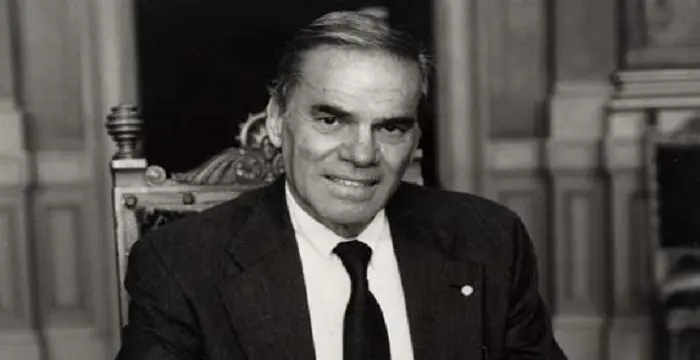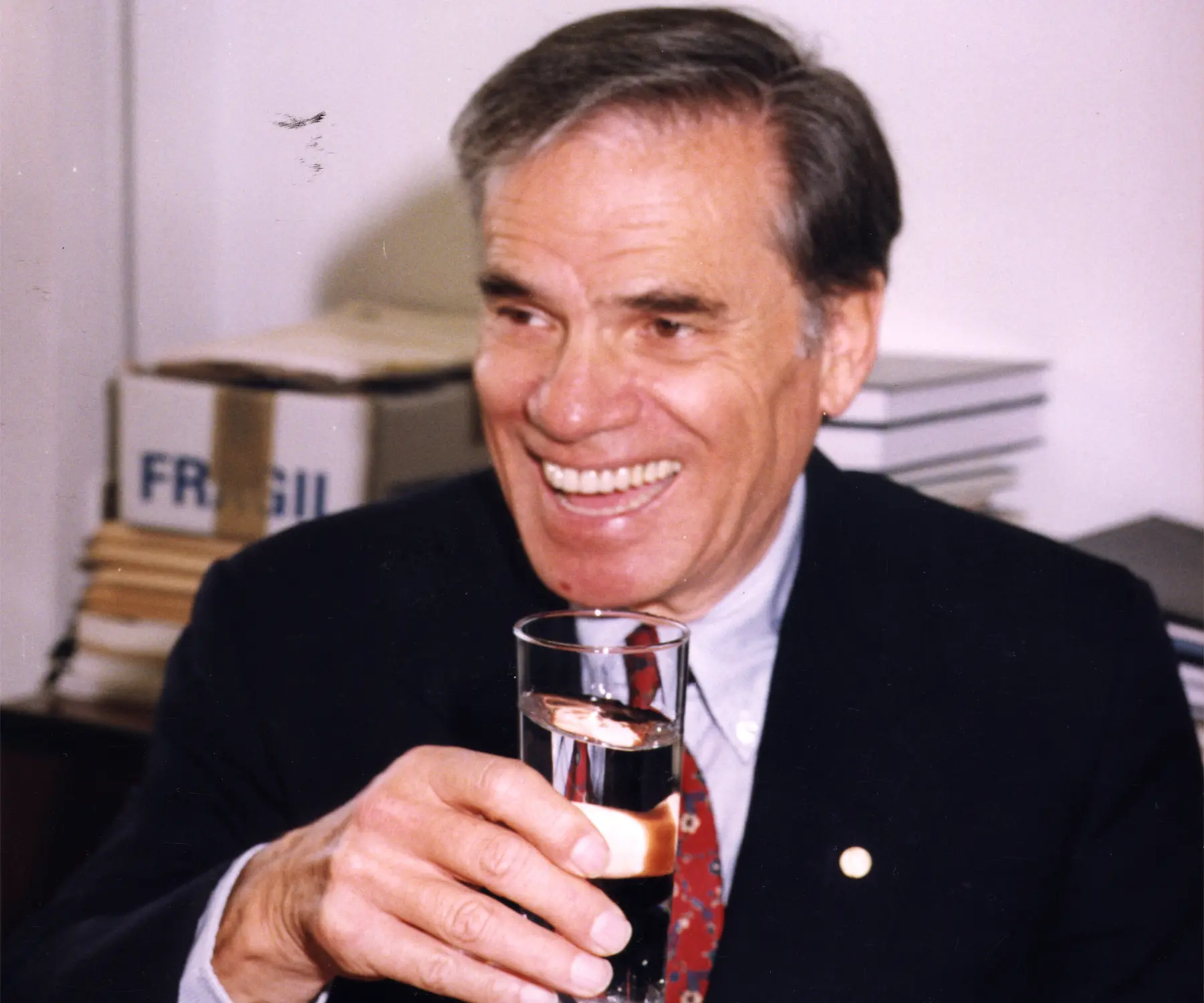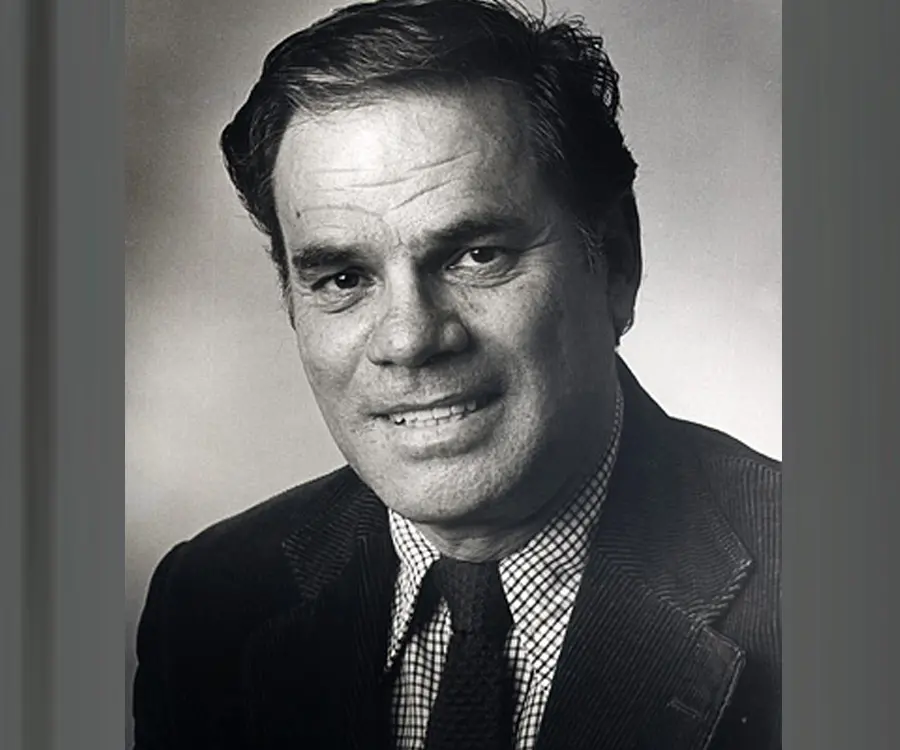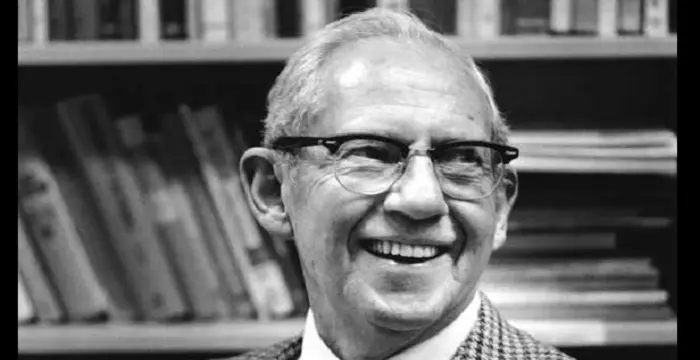
Martin Rodbell - Biochemists, Life Achievements and Childhood
Martin Rodbell's Personal Details
Martin Rodbell was an American biochemist and molecular endocrinologist who received the 1994 Nobel Prize in Physiology or Medicine
| Information | Detail |
|---|---|
| Birthday | December 1, 1925 |
| Died on | December 7, 1998 |
| Nationality | American |
| Famous | University Of Washington, Scientists, Biochemists |
| City/State | Maryland |
| Spouses | Barbara Charlotte Ledermann |
| Childrens | Andrew, Paul, Phillip, Suzanne |
| Universities |
|
| Notable Alumnis |
|
| Birth Place | Baltimore, Maryland, U.S. |
| Gender | Male |
| Father | Milton Rodbell |
| Mother | Shirley (née Abrams) Rodbell |
| Sun Sign | Sagittarius |
| Born in | Baltimore, Maryland, U.S. |
| Famous as | Biochemist |
| Died at Age | 73 |
// Famous Biochemists
Robert Huber
Robert Huber is a German biochemist and Nobel Laureate. Check out this biography to know about his childhood, life, achievements, works & timeline.
Charles Best
Charles Best was a great scientist and a renowned physiologist who is remembered for being the co-discoverer of insulin. Read this biography to learn about his profile, childhood, life and timeline.
Isaac Asimov
Isaac Asimov was an American professor of biochemistry and a renowned author of science fiction and popular science books. Read this biography to know more about his life.
Martin Rodbell's photo
Who is Martin Rodbell?
Martin Rodbell was an American biochemist and molecular endocrinologist who received the 1994 Nobel Prize in Physiology or Medicine with Alfred G. Gilman. Although his parents wanted him to pursue medicine he earned his bachelor’s degree in biology from John Hopkins University and PhD from Washington University at Seattle. Subsequently, after two years of postdoctoral work at the University of Illinois, he joined National Institute of Health and began his career as a researcher at its National Heart Institute at Bethesda. Here he began his work on lipoproteins and successfully detected five different proteins. But very soon, he left this field to study the functions of hormoneson isolated cells. Afterward, on being inspired by Sutherland’s theory of ‘second messenger’, he began working on ‘signal transduction’, which led to the discovery of G-protein. This work earned him the Nobel Prize in Physiology or Medicine. Apart from being an excellent scientist, he was also a warm and friendly human being. In later years, he interacted with youngsters and encouraged them to take up basic research. He pressed upon the fact that one need not be privileged or extraordinary in order to make major scientific contributions.
// Famous Scientists
Juliane Koepcke
Juliane Koepcke is a German-Peruvian biologist, who was the lone survivor among the 92 passengers and crew of the ill-fated LANSA Flight 508 that crashed in the Peruvian rainforest on 24 December 1971. Know more about her life in this biography.
Henry Cavendish
Henry Cavendish was a theoretical chemist and physicist, renowned for discovery of hydrogen and calculation of the mass of earth. To know more about his childhood, profile, timeline and career read on
Konstantin Tsiolkovsky
Konstantin Tsiolkovsky was a Russian rocket scientist and a pioneer of astronautics. This biography provides detailed information about his childhood, family, personal life, career, achievements, etc.
Childhood & Early Years
Martin Rodbell was born on December 1, 1925 in Baltimore, Maryland into a Jewish family. His father, Milton Rodbell, was a grocer. His mother’s name was Shirley (née Abrams) Rodbell. He had one brother and one sister.
Rodbell started his education at a public school. Later he shifted to Baltimore City College, a magnet high school, which admitted selected students from the city and put more stress on languages than on science subjects.
As a result, he soon developed interest in languages, especially French. At the same time, his friendship with two neighborhood boys awakened in him a great interest in chemistry and mathematics.
Finally, after passing out from school in 1943, he joined John Hopkins University with chemistry and French existential literature. Soon he began to feel that being a Jew, fighting Hitler should be his highest priority. So in 1944, he joined the U.S. Navy as a radio operator.
His Corp was mainly engaged with the Japanese in the South Pacific. During this period, he had the opportunity to interact with the locals, living under trying conditions, in Philippines, Korea and China. This, in his own words, helped him grow a ‘healthy respect for the human condition’.
In 1946, after being released from military service, he rejoined John Hopkins University. Although his father wanted him to study medicine he was more interested in French. While he was going through this dilemma, he was caught by the enthusiasm of Professor Bentley Glass, who advised him to enter the field of biochemistry.
Therefore, he decided to major in biology; but because he had not studied advanced chemistry he had to spend one more year taking this course. Finally he received his bachelor’s degree in biology in 1949.
Subsequently, he joined the University of Washington, Seattle and there he began his doctoral work on the biosynthesis of lecithin in the rat liver and received his PhD in 1954.
Career
In 1954, soon after receiving his PhD, Rodbell joined University of Illinois at Urbana-Champaign as a postdoctoral fellow. Here he worked on biosynthesis of the antibiotic chloramphenicol under Herbert E. Carter.
His fellowship period ended in 1956. By now, Rodbell had realized that he was not cut out for an academic career and research was his strong point.
Therefore, he accepted the position of research biochemist at National Heart Institute in Bethesda, Maryland. It was a part of the National Institutes of Health and Rodbell remained with the organization until his retirement in 1994.
Here he began to work on lipoproteins on the surface of chylomicrons. Using a newly developed ‘fingerprinting’ technique he detected at least five different proteins. Much later it was proved that these proteins had major roles in diseases involving lipoproteins.
In 1960, he decided to restart his original research on cell biology. Fortunately, he received a fellowship, which enabled him to join the University of Brussels. There he learned many new techniques. Among them, he found an ultrathin x-ray film process to record localization of tritium-labeled molecules inside the cells most interesting.
Later he shifted to Leiden, Netherland, where he joined the laboratory of Dr. Peter Gaillard, a pioneer in the techniques of cell culturing. Here he obtained training in the use of cultured heart cells for determining the uptake of tritium-labeled chylomicrons.
On returning to the US, Rodbell joined the Nutrition and Endocrinology laboratory of NIH’s Institute of Arthritis and Metabolic Diseases. Here he began to work on fat cells and sowed that these cells are released when collagenase digest the tissue matrix.
Later he also developed a method by which these cells can be separated and purified without altering the cell structure. Subsequently in 1963, he was visited by Bernardo Houssay, who ignited in him an interest in how hormones work on isolated cells. Rodbell immediately started working on it.
By 1964, he published the results of his experiments in an article titled, ‘The Metabolism of Isolated Fat Cells’. It was highly appreciated by the scientific community and was hailed as one of the most important papers in endocrinology in 1960s and 1970s.
In 1965, Earl W. Sutherland gave a talk on ‘second messenger’ theory of hormone activity. Sutherland had hypothesized that a hormone, the ‘first messenger’, does not enter a cell. Rather it works on the surface, triggering a mechanism, he called ‘second messenger’, within the cell. It is the second messenger, which executes the command initiated by the hormone.
Rodbell, like many other biochemists, was intrigued by it and his interest turned to cyclic AMP paradigm. Meanwhile in 1967, he travelled to Geneva to take the place of Albert E. Renold at the Institut de Biochimie Clinique while Renold took some time off.
At Geneva, he worked on the effects of hormones on ion and amino acid translocations in fat cell ghosts. Subsequently, he returned to the US in 1968 and began working with rat liver membrane cells on signal transduction. He soon found similarity between computers and biological organisms.
He believed that just like computers, a biological organism has a cell receptor, which receives information from outside the cell; a cell transducer, which processes this information across the cell membrane; and the amplifier that intensifies these signals to initiate reactions within the cell or to transmit information to other cells.
While the functions of the cell receptor and the amplifier were known, nothing much was known about the cell transducer. In 1970, Rodbell discovered that the principal component of the transducer was guanosine triphosphate (GTP).
Subsequently, he demonstrated that GTP stimulated the guanine nucleotide protein (later called G-protein), present in the cell membrane. He also said that activated G-protein was the "second messenger" process that Earl W. Sutherland had theorized.
In 1985, Rodbell was transferred to the NIH's National Institute of Environmental Health Sciences in Research Triangle Park, North Carolina, where he joined as the Scientific Director. He stayed there until his retirement 1994.
Meanwhile 1991, he also functioned as the Adjunct Professor of Cell Biology at Duke University, remaining there until 1998. For a brief period, he was also the Adjunct Professor of Pharmacology at the University of North Carolina at Chapel Hill.
Major Works
Rodbell is best remembered for his work on ‘signal transduction’ and discovery of G-protein. He established that the G-protein, present in the cell membrane, was the main factor that carries on theprocess of transduction.
Later he established that addition of G-proteins at the cell receptor could inhibit and activate transduction simultaneously. By this, he showed that cellular receptors were capable of having several processes going on at the same time.
Awards & Achievements
In 1994, Martin Rodbell received the Nobel Prize in Physiology or Medicine for “discovery of G-proteins and the role of these proteins in signal transduction in cells". He shared the prize with Alfred G. Gilman, who had worked independently on the same subject around the same time.
In addition to that, he received Gairdner Foundation International Award in 1984 and Richard Lounsbery Award in 1987.
Personal Life & Legacy
In 1950, Rodbell married Barbara Charlotte Ledermann. She was a friend of Ann Frank’s (the famous diarist) sister Margot. Although her parents and sister were gassed to death at Auschwitz, Charlotte was able to obtain an Aryan I Card through her contacts in the Dutch Underground and survive. The couple had four children - Paul, Suzanne, Andrew, and Phillip.
Towards the end of his life Rodbell began to suffer from cardiovascular disease. Yet, he was highly active. On 16 November, 1998 he delivered the inaugural NIEHS Rodbell Lecture. The next day he was admitted to the hospital and died on December 7, 1998 in Chapel Hill, North Carolina.
Trivia
The news that he had been awarded the Nobel Prize was conveyed to Rodbell over the telephone by a representative of the Swedish Academy. At that time it was 6 AM in the U.S.A and he was fast asleep in his daughter’s house at Bethesda. So when he was asked if he was ready to accept the prize all he could say was “Do you think I should accept?” The representative said that he should and so he said, “Ok, I accept”.
// Famous University Of Washington
George Joseph Stigler
George Stigler was one of the most influential economists of the 20th century. Check out this biography to know about his childhood, family life, achievements and other facts related to his life.
Amanda Knox
Amanda Marie Knox is an American writer and activist who had to spend almost four years in an Italian prison for a wrongful conviction.
Joel McHale
Joel McHale is an American comedian, actor, producer, host, and writer. Check out this biography to know about his birthday, childhood, family life, achievements and fun facts about him.
Martin Rodbell's awards
| Year | Name | Award |
|---|---|---|
Other | ||
| 0 | Nobel Prize in Physiology or Medicine (1994) | |
| 0 | Gairdner Foundation International Award (1984) | |
| 0 | Richard Lounsbery Award (1987) | |
Martin Rodbell biography timelines
- // 1st Dec 1925Martin Rodbell was born on December 1, 1925 in Baltimore, Maryland into a Jewish family. His father, Milton Rodbell, was a grocer. His mother’s name was Shirley (née Abrams) Rodbell. He had one brother and one sister.
- // 1943 To 1944Finally, after passing out from school in 1943, he joined John Hopkins University with chemistry and French existential literature. Soon he began to feel that being a Jew, fighting Hitler should be his highest priority. So in 1944, he joined the U.S. Navy as a radio operator.
- // 1946In 1946, after being released from military service, he rejoined John Hopkins University. Although his father wanted him to study medicine he was more interested in French. While he was going through this dilemma, he was caught by the enthusiasm of Professor Bentley Glass, who advised him to enter the field of biochemistry.
- // 1949Therefore, he decided to major in biology; but because he had not studied advanced chemistry he had to spend one more year taking this course. Finally he received his bachelor’s degree in biology in 1949.
- // 1950In 1950, Rodbell married Barbara Charlotte Ledermann. She was a friend of Ann Frank’s (the famous diarist) sister Margot. Although her parents and sister were gassed to death at Auschwitz, Charlotte was able to obtain an Aryan I Card through her contacts in the Dutch Underground and survive. The couple had four children - Paul, Suzanne, Andrew, and Phillip.
- // 1954Subsequently, he joined the University of Washington, Seattle and there he began his doctoral work on the biosynthesis of lecithin in the rat liver and received his PhD in 1954.
- // 1954In 1954, soon after receiving his PhD, Rodbell joined University of Illinois at Urbana-Champaign as a postdoctoral fellow. Here he worked on biosynthesis of the antibiotic chloramphenicol under Herbert E. Carter.
- // 1956His fellowship period ended in 1956. By now, Rodbell had realized that he was not cut out for an academic career and research was his strong point.
- // 1960In 1960, he decided to restart his original research on cell biology. Fortunately, he received a fellowship, which enabled him to join the University of Brussels. There he learned many new techniques. Among them, he found an ultrathin x-ray film process to record localization of tritium-labeled molecules inside the cells most interesting.
- // 1963Later he also developed a method by which these cells can be separated and purified without altering the cell structure. Subsequently in 1963, he was visited by Bernardo Houssay, who ignited in him an interest in how hormones work on isolated cells. Rodbell immediately started working on it.
- // 1964By 1964, he published the results of his experiments in an article titled, ‘The Metabolism of Isolated Fat Cells’. It was highly appreciated by the scientific community and was hailed as one of the most important papers in endocrinology in 1960s and 1970s.
- // 1965In 1965, Earl W. Sutherland gave a talk on ‘second messenger’ theory of hormone activity. Sutherland had hypothesized that a hormone, the ‘first messenger’, does not enter a cell. Rather it works on the surface, triggering a mechanism, he called ‘second messenger’, within the cell. It is the second messenger, which executes the command initiated by the hormone.
- // 1967Rodbell, like many other biochemists, was intrigued by it and his interest turned to cyclic AMP paradigm. Meanwhile in 1967, he travelled to Geneva to take the place of Albert E. Renold at the Institut de Biochimie Clinique while Renold took some time off.
- // 1968At Geneva, he worked on the effects of hormones on ion and amino acid translocations in fat cell ghosts. Subsequently, he returned to the US in 1968 and began working with rat liver membrane cells on signal transduction. He soon found similarity between computers and biological organisms.
- // 1970While the functions of the cell receptor and the amplifier were known, nothing much was known about the cell transducer. In 1970, Rodbell discovered that the principal component of the transducer was guanosine triphosphate (GTP).
- // 1984 To 1987In addition to that, he received Gairdner Foundation International Award in 1984 and Richard Lounsbery Award in 1987.
- // 1985 To 1994In 1985, Rodbell was transferred to the NIH's National Institute of Environmental Health Sciences in Research Triangle Park, North Carolina, where he joined as the Scientific Director. He stayed there until his retirement 1994.
- // 1991 To 1998Meanwhile 1991, he also functioned as the Adjunct Professor of Cell Biology at Duke University, remaining there until 1998. For a brief period, he was also the Adjunct Professor of Pharmacology at the University of North Carolina at Chapel Hill.
- // 1994Therefore, he accepted the position of research biochemist at National Heart Institute in Bethesda, Maryland. It was a part of the National Institutes of Health and Rodbell remained with the organization until his retirement in 1994.
- // 1994In 1994, Martin Rodbell received the Nobel Prize in Physiology or Medicine for “discovery of G-proteins and the role of these proteins in signal transduction in cells". He shared the prize with Alfred G. Gilman, who had worked independently on the same subject around the same time.
- // 7th Dec 1998Towards the end of his life Rodbell began to suffer from cardiovascular disease. Yet, he was highly active. On 16 November, 1998 he delivered the inaugural NIEHS Rodbell Lecture. The next day he was admitted to the hospital and died on December 7, 1998 in Chapel Hill, North Carolina.
// Famous Maryland peoples
Teddy Zois
Teddy Zois is an American Musical.ly star and social media personality. Let’s have a look at his family and personal life including age, date of birth, net worth, and fun facts.
Reed Deming
Check out all that you wanted to know about Reed Deming, the famous pop singer; his birthday, his family and personal life, his girlfriends, fun trivia facts and more.
Bryce Hall
Check out all that you wanted to know about Bryce Hall, the famous American Musical.ly star & YouTube personality; his birthday, his family and personal life, his girlfriends, fun trivia facts and more.
Jessie Usher
Jessie Usher in as American actor. Check out this biography to know about his childhood, family, personal life, age, birthday, etc.
Cyrus Dobre
Cyrus Dobre is an American YouTuber. Check out this biography to know about his birthday, childhood, family life, achievements and fun facts about him.
Evan Eckenrode
Evan Eckenrode, better known as ‘dwarf mamba,’ is a popular YouTuber. Let’s have a look at his family, personal life, age, birthday, etc.
Martin Rodbell's FAQ
What is Martin Rodbell birthday?
Martin Rodbell was born at 1925-12-01
When was Martin Rodbell died?
Martin Rodbell was died at 1998-12-07
Where was Martin Rodbell died?
Martin Rodbell was died in Chapel Hill, North Carolina, U.S.
Which age was Martin Rodbell died?
Martin Rodbell was died at age 73
Where is Martin Rodbell's birth place?
Martin Rodbell was born in Baltimore, Maryland, U.S.
What is Martin Rodbell nationalities?
Martin Rodbell's nationalities is American
Who is Martin Rodbell spouses?
Martin Rodbell's spouses is Barbara Charlotte Ledermann
Who is Martin Rodbell childrens?
Martin Rodbell's childrens is Andrew, Paul, Phillip, Suzanne
What was Martin Rodbell universities?
Martin Rodbell studied at University Of Washington, Johns Hopkins University, University of Washington
What was Martin Rodbell notable alumnis?
Martin Rodbell's notable alumnis is University Of Washington
Who is Martin Rodbell's father?
Martin Rodbell's father is Milton Rodbell
Who is Martin Rodbell's mother?
Martin Rodbell's mother is Shirley (née Abrams) Rodbell
What is Martin Rodbell's sun sign?
Martin Rodbell is Sagittarius
How famous is Martin Rodbell?
Martin Rodbell is famouse as Biochemist
















